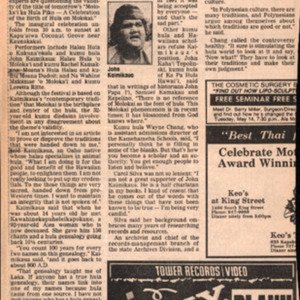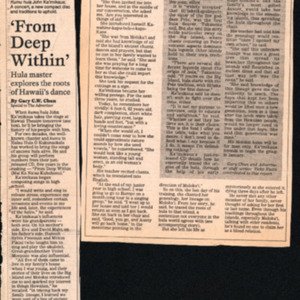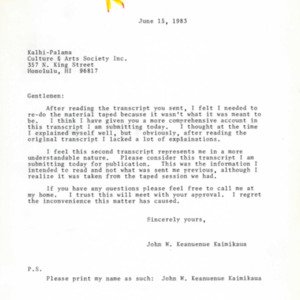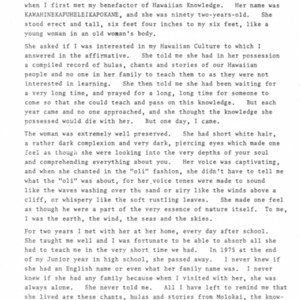John W. Keanuenue Ka‘imikaua
Title
John W. Keanuenue Ka‘imikaua
Description
John W. Keānuenue Kaʻimikaua
John Kaʻimikaua began to formally teach in 1977 with the establishment of Hālau Hula O Kukunaokalā.
I was but a very young boy of fourteen years standing six feet tall when I first met my benefactor of Hawaiian knowledge. Her name was Kawahinekapuheleikapōkāne and she was ninety-two-years- old. She stood erect and tall, six feet four inches to my six feet, like a young woman in an old womans body.
She asked if I was interested in my Hawaiian culture to which I answered in the affirmative. She told me she had in her possession a compiled record of hulas, chants, and stories of our Hawaiian people and no one in her family was interested in learning them. She then told me she had been waiting and praying for a very long time for someone to come so that she could teach and pass on this knowledge. But each year passed and no one approached and she thought the knowledge she possessed would die with her.
The woman was extremely well-preserved. She had short, white hair, a rather dark complexion, and very dark, piercing eyes which made one feel as though she were looking into the very depths of your soul and comprehending everything about you. Her voice was captivating, and when she chanted in the oli fashion she didn’t have to tell me what the oli was about for her voice tones were made to sound like the waves washing over the sand or airy like the winds above a cliff or whispery like the soft rustling leaves. She made me feel as though I were a part of the very essence of nature itself. To me, I was the earth, the wind, the seas, and the skies.
For two years I met with her at her home everyday after school. She taught me well and I was fortunate to be able to absorb all she had to teach me in the very short time we had. In 1975 at the end of my junior year in high school she passed away. I never knew if she had an English name or even what her family name was. I never knew if she had any family because when I visited with her she was always alone. All I have left to remind me that she lived are these chants, hulas, and stories from Molokaʻi and a genealogy of my line of kumu hula ending with her.
During my time of study with her, Kawahine explained the genealogy and told me of the descendency of my line of kumu hula which reverts all the way back to Laka and five more generations beyond her. She further explained that for every two kumus on the genealogy chart, the time span marks a hundred years. With the genealogy I possess; the chants, hulas, stories, and historical records she shared with me would date back to 900 A.D. Each kumu in the genealogy kept a record of what transpired during their lifetime. They recorded the births and deaths of ali‘is, chiefs, and other notable people in Hawaiian history. They recorded events, wars, and life-styles of the people. They wrote of the foods planted, the animals in abundance, the work labored and the changes in the land. All this and more was recorded in the chants and stories left me by my benefactor, all written in Hawaiian, some translated to English.
One of the most significant treasures of information which Kawahine imparted to me was the knowledge that the race of people the Hawaiians descended from, once had an ancient written language that long prevailed in their record keeping and everyday communication. It consisted of symbols representing nouns and verbs, and read from top to bottom. The sentence structure was ordered from right to left. This written language was taught to each kumu in the genealogy line as a means to preserve this art, for the language soon disappeared from the people because of a lack of use as the life-styles of the people changed.
The stories and beliefs of the early Hawaiians regarding extraordinary animals, people, and events were based on realistic happenings and factual accounts. Today they are regarded as myths and legends. For example through the chants, it relates how Molokaʻi at one time was over-run by huge mo‘o or lizards. The kumus recorded these lizards to be the size of mountain ridges. These creatures had an almost human-like intelligence and had the ability to communicate with man. Another aspect recorded in the chants tells of giants who once lived and thrived on the land. The events that are recorded in some of these chants are unbelievable but then our world today would be just as unbelievable to other people in the past or in the future.
The combined land area of all eight Hawaiian Islands today are but a tenth of what the lands of Hawaiʻi once were. The extent of the land at one time was so great that it supported a population of millions of inhabitants. There were no separate islands per se but all were connected. The separation of this land occurred through mass destruction generated by earthquakes and other natural occurrences which resulted in the sinking of nine- tenths of the land and much of the inhabitants into the ocean.
But I turn my thoughts to Molokaʻi again and relate the significant aspect of this epistle. It was on this island of Moloka'i that Laka was born and taught the hula by her older sister Kapoulakīnaʻu. At that time only the family of Laka possessed the knowledge and artistic skills of the hula and it was retained and taught only to the members of her family. It was only after Laka attained this knowledge and art that she spread this art form to every island. First to Ni'ihau, then Kauaʻi, Oʻahu, Maui, Lānaʻi, and lastly to the Big Island of Hawaiʻi. Wherever she traveled, academies of dance were started and the traditions were carried forth by her ardent students. When age crept upon her, Laka returned to Molokaʻi where she spent her remaining years enmeshed in her dance and died in the place called Kaʻana.
What is sorely missing in the ancient hula today is the purity of spirit within each individual kumu and dancer. Ancient hula is spiritual. When we perform we are indeed re-enacting the past life of our forefathers, and we must be clean from the inside-out in order to spiritually satisfy and represent the hula according to tradition. The hula was held sacred and was a means of expressing the life-styles and culture of our forefathers. It was not entertainment but their way of communicating effectively. Our whole Hawaiian culture: its lifestyles, government, temple ceremonies, genealogy, and interests were preserved in these chants.
When Kawahine gave me her knowledge, she did so with these words which long have remained imprinted upon my mind. She said, ‘I give you all that I have which is pure and true and all that now remains, for this knowledge of sacred records once flourished like a tree with many branches from Kaʻana and extended far into the corners of our lands. But eventually the branches withered and died and only the aged trunk remained. My predecessors foretold of this breaking away and so we (the kumus) have carefully guarded and nurtured the trunk of this tree. This I give to you. The true knowledge of our Hawaiian people.’
The hula is the inspiration that will enable the Hawaiians to rise up from the dust out of obscurity. It is the last hope that can make us feel Hawaiian and remember our culture and forefathers. The dance will thus be the last of our cultural strongholds that may well preserve our dying heritage.
John Kaʻimikaua began to formally teach in 1977 with the establishment of Hālau Hula O Kukunaokalā.
I was but a very young boy of fourteen years standing six feet tall when I first met my benefactor of Hawaiian knowledge. Her name was Kawahinekapuheleikapōkāne and she was ninety-two-years- old. She stood erect and tall, six feet four inches to my six feet, like a young woman in an old womans body.
She asked if I was interested in my Hawaiian culture to which I answered in the affirmative. She told me she had in her possession a compiled record of hulas, chants, and stories of our Hawaiian people and no one in her family was interested in learning them. She then told me she had been waiting and praying for a very long time for someone to come so that she could teach and pass on this knowledge. But each year passed and no one approached and she thought the knowledge she possessed would die with her.
The woman was extremely well-preserved. She had short, white hair, a rather dark complexion, and very dark, piercing eyes which made one feel as though she were looking into the very depths of your soul and comprehending everything about you. Her voice was captivating, and when she chanted in the oli fashion she didn’t have to tell me what the oli was about for her voice tones were made to sound like the waves washing over the sand or airy like the winds above a cliff or whispery like the soft rustling leaves. She made me feel as though I were a part of the very essence of nature itself. To me, I was the earth, the wind, the seas, and the skies.
For two years I met with her at her home everyday after school. She taught me well and I was fortunate to be able to absorb all she had to teach me in the very short time we had. In 1975 at the end of my junior year in high school she passed away. I never knew if she had an English name or even what her family name was. I never knew if she had any family because when I visited with her she was always alone. All I have left to remind me that she lived are these chants, hulas, and stories from Molokaʻi and a genealogy of my line of kumu hula ending with her.
During my time of study with her, Kawahine explained the genealogy and told me of the descendency of my line of kumu hula which reverts all the way back to Laka and five more generations beyond her. She further explained that for every two kumus on the genealogy chart, the time span marks a hundred years. With the genealogy I possess; the chants, hulas, stories, and historical records she shared with me would date back to 900 A.D. Each kumu in the genealogy kept a record of what transpired during their lifetime. They recorded the births and deaths of ali‘is, chiefs, and other notable people in Hawaiian history. They recorded events, wars, and life-styles of the people. They wrote of the foods planted, the animals in abundance, the work labored and the changes in the land. All this and more was recorded in the chants and stories left me by my benefactor, all written in Hawaiian, some translated to English.
One of the most significant treasures of information which Kawahine imparted to me was the knowledge that the race of people the Hawaiians descended from, once had an ancient written language that long prevailed in their record keeping and everyday communication. It consisted of symbols representing nouns and verbs, and read from top to bottom. The sentence structure was ordered from right to left. This written language was taught to each kumu in the genealogy line as a means to preserve this art, for the language soon disappeared from the people because of a lack of use as the life-styles of the people changed.
The stories and beliefs of the early Hawaiians regarding extraordinary animals, people, and events were based on realistic happenings and factual accounts. Today they are regarded as myths and legends. For example through the chants, it relates how Molokaʻi at one time was over-run by huge mo‘o or lizards. The kumus recorded these lizards to be the size of mountain ridges. These creatures had an almost human-like intelligence and had the ability to communicate with man. Another aspect recorded in the chants tells of giants who once lived and thrived on the land. The events that are recorded in some of these chants are unbelievable but then our world today would be just as unbelievable to other people in the past or in the future.
The combined land area of all eight Hawaiian Islands today are but a tenth of what the lands of Hawaiʻi once were. The extent of the land at one time was so great that it supported a population of millions of inhabitants. There were no separate islands per se but all were connected. The separation of this land occurred through mass destruction generated by earthquakes and other natural occurrences which resulted in the sinking of nine- tenths of the land and much of the inhabitants into the ocean.
But I turn my thoughts to Molokaʻi again and relate the significant aspect of this epistle. It was on this island of Moloka'i that Laka was born and taught the hula by her older sister Kapoulakīnaʻu. At that time only the family of Laka possessed the knowledge and artistic skills of the hula and it was retained and taught only to the members of her family. It was only after Laka attained this knowledge and art that she spread this art form to every island. First to Ni'ihau, then Kauaʻi, Oʻahu, Maui, Lānaʻi, and lastly to the Big Island of Hawaiʻi. Wherever she traveled, academies of dance were started and the traditions were carried forth by her ardent students. When age crept upon her, Laka returned to Molokaʻi where she spent her remaining years enmeshed in her dance and died in the place called Kaʻana.
What is sorely missing in the ancient hula today is the purity of spirit within each individual kumu and dancer. Ancient hula is spiritual. When we perform we are indeed re-enacting the past life of our forefathers, and we must be clean from the inside-out in order to spiritually satisfy and represent the hula according to tradition. The hula was held sacred and was a means of expressing the life-styles and culture of our forefathers. It was not entertainment but their way of communicating effectively. Our whole Hawaiian culture: its lifestyles, government, temple ceremonies, genealogy, and interests were preserved in these chants.
When Kawahine gave me her knowledge, she did so with these words which long have remained imprinted upon my mind. She said, ‘I give you all that I have which is pure and true and all that now remains, for this knowledge of sacred records once flourished like a tree with many branches from Kaʻana and extended far into the corners of our lands. But eventually the branches withered and died and only the aged trunk remained. My predecessors foretold of this breaking away and so we (the kumus) have carefully guarded and nurtured the trunk of this tree. This I give to you. The true knowledge of our Hawaiian people.’
The hula is the inspiration that will enable the Hawaiians to rise up from the dust out of obscurity. It is the last hope that can make us feel Hawaiian and remember our culture and forefathers. The dance will thus be the last of our cultural strongholds that may well preserve our dying heritage.
Citation
“John W. Keanuenue Ka‘imikaua,” Nā Kumu Hula Archive, accessed November 28, 2025, https://nakumuhula.org/archive/items/show/53.









